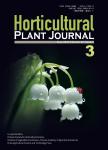Natural variation of main biochemical components,morphological and yield traits among a panel of 87 tea [Camellia sinensis(L.) O. Kuntze] cultivars
[Camellia sinensis (L.) O. Kuntze] cultivars作者机构:Key Laboratory of Horticultural Plant Biology of Ministry of EducationHuazhong Agricultural UniversityWuhanHubei 430070China College of Horticulture and Forestry SciencesHuazhong Agricultural UniversityWuhanHubei 430070China College of Plant Science and TechnologyHuazhong Agricultural UniversityWuhanHubei 430070China
出 版 物:《Horticultural Plant Journal》 (园艺学报(英文版))
年 卷 期:2023年第9卷第3期
页 面:563-576页
核心收录:
学科分类:0710[理学-生物学] 09[农学] 090203[农学-茶学] 0902[农学-园艺学]
基 金:jointly supported by the National Key Research and Development Program of China (Grant No. 2021YFD1000401) the National Natural Science Foundation of China (Grant No.32070376) the Program of Horticultural Crop Germplasm Resources in Hubei Province (Grant No. 2021DFE016) the Key Technology of Safety Production to Improve Tea Quality and Efficiency in Three Gorges Reservoir Area
主 题:Camellia sinensis Biochemical components Germplasm Natural variation Morphology Yield
摘 要:Many attentions have been previously focused to identify the multiple biochemical components related to tea quality and health benefits,however, the natural variation of biochemical components present in tea germplasm has not been adequately evaluated. In this study, the main biochemical components, leaf morphological and yield characteristics were evaluated for four rounds of tea leaves in a panel of 87 elite tea cultivars suitable for black, green, or oolong tea. Significant variations were observed among the tea cultivars, as well as seasonal differences in the levels of the free amino acid(FAA), caffeine(CAF), tea polyphenols(TP), water extract(WE) and TP to FAA ratio(TP/FAA). Results showed that the average levels of FAA showed a seasonal change, with the highest level of 4.0% in the 1st spring tea in the cultivars suitable for green tea and the lowest of 3.2% in summer tea in the cultivars suitable for black tea. The average CAF content was highest 3.2% in the cultivars suitable for oolong tea in the 1st spring and the lowest 2.5% in the cultivars suitable for green tea in summer. Limited seasonal and varietal variations were noticed in the average levels of WE among the three categories of tea. In addition, significant natural variation of the morphological characteristics, bud length varying from 2.5 cm to 8.7 cm, bud density from 190.3 buds · m-2to 1 730.3 buds · m-2, mature leaves biomass from 128.4 kg · hm-2to 2 888.4 kg · hm-2, and yield component traits of 100 buds(one bud with two leaves) dry weight from 3.7 g to37.7 g, tea yield/round from 444.6 kg · hm-2to 905.3 kg · hm-2, were observed. The aim of our evaluation was not only to identify the advantages of seasonal and clonal variations but also to provide a new viewpoint for their further application. Representative accessions were selected from the germplasm to promote the establishment of an inherent biochemical constituent expressing the quality of black, green, and oolong tea. The findings might



